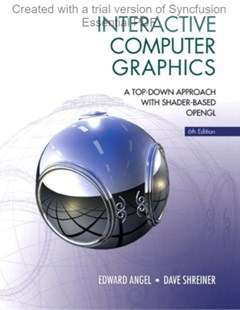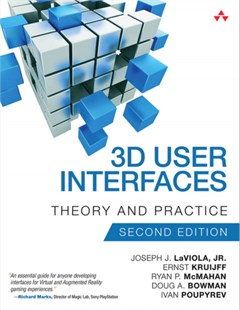Interactive Computer Graphics (6th Edition)
This book is suitable for undergraduate students in computer science and engineering, for students in other disciplines who have good programming skills, and for professionals.
2012
Computer animation and graphics–once rare, complicated, and comparatively expensive–are now prevalent in everyday life from the computer screen to the movie screen.
Interactive Computer Graphics: A Top-Down Approach with Shader-Based OpenGL, 6e, is the only introduction to computer graphics text for undergraduates that fully integrates OpenGL 3.1 and emphasizes application-based programming.
Using C and C++, the top-down, programming-oriented approach allows for coverage of engaging 3D material early in the text so readers immediately begin to create their own 3D graphics. Low-level algorithms (for topics such as line drawing and filling polygons) are presented after readers learn to create graphics.
All references in this paragraph refers to the book:
+ Chapter 1 - (All) Pinhole camera, human visual system, graphics pipeline
+ Chapter 2 - (All) This chapter gives a quick introduction to OpenGL and simple GLSL. Most content is repeated in other chapters, but this chapter ties it together nicely.
+ Chapter 3 - (All except 3.13-3.14) Definitions: Scalars, points, vectors, dot & cross product, frames.
Transformation: Translation, rotation & scaling.
Concatenation of transforms.
Coordinate frames, homogeneous coordinates.
+ Chapter 4 - (4.3-4.9)
Derivation of camera transform from VRP, VPN and VUP (the LookAt function). Perspective projection including matrix representation. The z-buffer and backface culling (4.8).
+ Chapter 5 - (All except 5.6 and 5.11)
Light sources. Diffuse and Specular shading.
The Phong shading model. GLSL
+ Chapter 6: (6.11) : Hidden surface removal, z-buffer
+ Chapter 7:
7.2, 7.4-7.6. Texture Mapping.
7.8-7.10 Environment Mapping, Reflection Map & Bump Mapping
+ Chapter 8:
8.1-8.2: Hierarchical Models
8.3-8.4: A robot arm
8.8: Scene Graphs
+ Chapter 9: (9.9 Procedural Noise)
+ Chapter 10:
10.1: Implicit and explicit representations
10.5: Hermite Curves
10.8.5: Catmull-Rom splines
+ Chapter 11:
11.2-11.3: Ray tracing
11.4: The rendering equation
Dave, Shreiner. "Interactive Computer Graphics." Pearson, 2012.
 |  |  |
| Interactive Computer Graphics (6th Edition) | 3D user interfaces: Theory and practice. Second edition | Begining 3D game development with unity 4: All-in-one, multi-platform-game development |
Chủ Nhật, 14:09 12/03/2023
Copyright © 2018 Hanoi University of Industry.